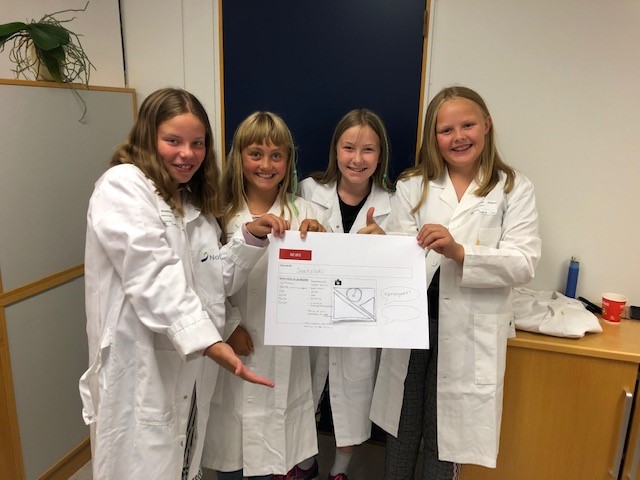ESR1 New methodologies in sensory and consumer research with preadolescents to guide product development of healthy, child-centred food

Objectives:
The thesis aim was to establish research-based knowledge on suitable consumer insight and food testing methodologies with preadolescents (appr. 9 to 12 years old), aimed at the development of healthy food products (by the food industry) and a better understanding of children’s perception of food (at an academic level). A special focus lay on an active engagement of preadolescents as the next generation of eaters in a changing world that requires adaption. The following objectives were addressed:
General objective:
To develop or to adapt age-specific data collection methods and corresponding statistical approaches to understand preadolescents’ food choices in the context of healthy product development.
Specific objectives:
- To explore how to get direct input from preadolescents into product development (co-creation) to formulate healthy products.
- To compare classic direct methods and new indirect methods (biometrics and implicit method) with preadolescents to study responses to product properties.
- To explore consumer methods to understand the influence of product properties in children’s responses to food including individual differences.
Summary of results:
Co-creation:
The potential of co-creation to develop healthier food that children would enjoy and choose was introduced in an opinion paper. Further, a methodological approach applicable to early stages of new product development was assessed for the ideation of healthy food concepts based on case studies in two settings, focus groups and online. Results provided first indications that children could develop concepts for healthy food in co-creation settings. The participative, explorative format was particularly engaging for children.
Indirect methods:
Two novel indirect methods were studied and compared to traditional questionnaire-based methods: implicit testing and biometrics.
The Approach Avoidance Task (AAT) as a particularly easy implicit reaction time task assessed children’s implicit approach biases to different snacks pictures. Results indicated a weak correlation of implicit bias to their expected liking ratings. Implicit testing seemed to be more related to concrete situational food preferences related to hunger state.
Further, a procedure to facilitate a standardized self-administered tasting by children was established for facial decoding as biometrics measurement. Apart from implicit facial expressions, children were asked to explicitly indicate with their faces how they felt about the tasted sample. Implicit as well as explicit basic emotions correlated with liking ratings, but explicit facial expressions were the most discriminative measurement.
Consumer-based method for sensory characterization:
Check-all-that-apply (CATA), an easy method to generate sensory descriptions of food products, was studied with children regarding individual differences in data quality according to ticking style (the way children used the CATA list). Children’s approach to the CATA task was studied by defining ticking style indicators: number of ticks, standard deviation of number of ticks per sample, and number of different attributes used in the test. Three groups of children were unveiled, and differences among groups may reflect different cognitive development levels.
Secondments:
- Secondment in public sector at the Norwegian Institute of Public Health (3 month) to collaborate on a publication investigating the relationship between weight status, self-perceived body weight and well-being in the European project CO-CREATE.
- Academic secondment with UNIFI (2 months), to explore methods from social psychology to measure implicit attitudes or biases.
- Academic secondment in UdelaR, (online due to the pandemic), to collaborate on a follow-up co-creation study on dairy product prototyping: https://doi.org/10.1016/j.foodqual.2021.104414
Publications by ESR1
- Galler, M., Gonera, A., & Varela, P. (2020). Children as food designers: The potential of co-creation to make the healthy choice the preferred one. International Journal of Food Design, 5, 125-131. https://doi.org/10.1386/ijfd_00015_3
- Galler, M., Mikkelsen, E., Næs, T., Liland, K. H., Ares, G., & Varela, P. (2022, 2022/03/01/). Children’s sweet tooth: Explicit ratings vs. Implicit bias measured by the Approach avoidance task (AAT). Food Quality and Preference, 96, 104416. https://doi.org/https://doi.org/10.1016/j.foodqual.2021.104416
- Galler, M., Næs, T., L. Almli, V., & Varela, P. (2020, 2020/12/01/). How children approach a CATA test influences the outcome. Insights on ticking styles from two case studies with 6–9-year old children. Food Quality and Preference, 86, 104009. https://doi.org/https://doi.org/10.1016/j.foodqual.2020.104009
- Velázquez, A. L., Galler, M., Vidal, L., Varela, P., & Ares, G. (2022, 2022/03/01/). Co-creation of a healthy dairy product with and for children. Food Quality and Preference, 96, 104414. https://doi.org/https://doi.org/10.1016/j.foodqual.2021.10441
Paper summaries
Blogposts by ESR1
“Children as co-creators of a healthy food product”
Children preferred to be product developers instead of helping an alien
Did you know that Norwegian children eat ramen after school?
co-creation, ESR1, method development, methodologies, pre-adolescents, product development

